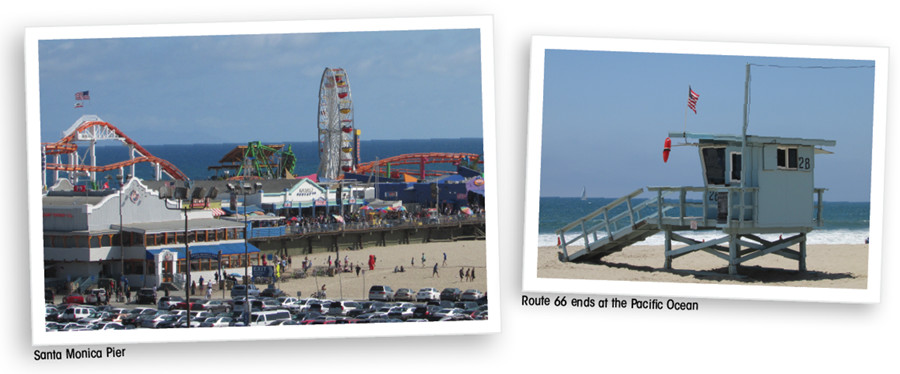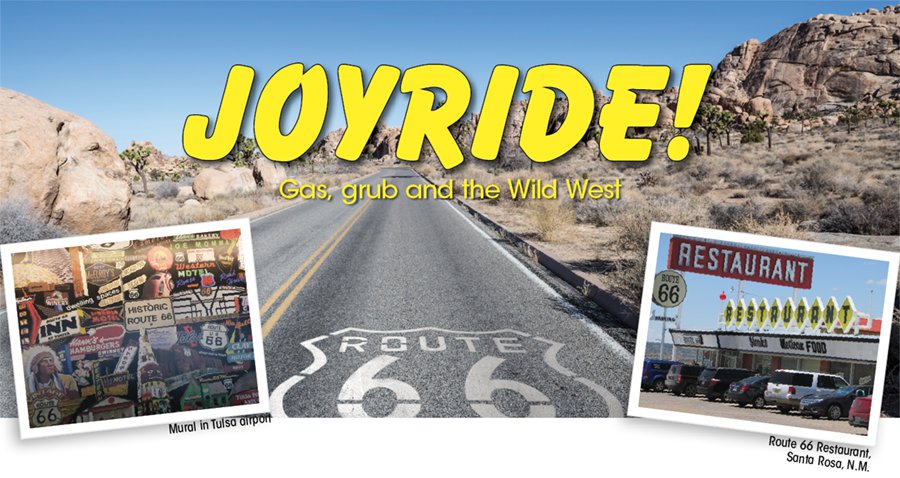This five-state adventure on old Route 66, originally printed a few years ago, is an armchair traveler's dream. That's especially true now because many people aren't taking road trips due to the pandemic.
Route 66, the iconic stretch of blacktop that runs from Chicago to L.A., beckons to road warriors like waves call to surfers. The Mother Road has long captured the country's imagination. It started with John Steinbeck's "The Grapes of Wrath," a book and movie about 1930s Okies heading west during the Dust Bowl, continued with the 1960s TV show "Route 66," and was re-popularized in the animated film series "Cars," which launched in 2006.
Take it from us: Cruising by the funky towns, greasy spoons, Art Deco buildings, neon signs and kitschy shops of America's Main Street is a journey through time. Gawking out the wide windshield of a Nissan Armada (no jalopy, this), rented from Hertz, we barnstormed from Oklahoma to California in 10 days. Straight from our travel diary, here's a peek at the five-state adventure.
 Day 1
Day 1
Tulsa to Oklahoma City
Early morning flight from RDU to Tulsa. Good thing the Hertz rental feels like a sumptuous couch - we'll be in this vehicle for 10 consecutive days. In the city of Tulsa, illustrious Art Deco architecture, the result of a 1920s oil boom, is extensive. In Tulsa! Who knew?
Put this set of wheels in high gear to make it to Oklahoma City by dark without jumping on I-40, which eclipsed Route 66 as a long-haul highway several decades ago.
Pass by classic Route 66 spots, including a skating rink frequented by roller derby teams and a flour silo, before taking a break at Pops in Arcadia. The café/gas station, which serves 400 kinds of soda, is fronted by a 66-foot-tall soda pop bottle.
Stay over in the Ambassador Hotel in Oklahoma City's Midtown, where the design of our handsome room is reminiscent of a well-tailored gentleman's suit.
 Day 2
Day 2
Oklahoma City to Amarillo, Texas
Breakfast at Sid's Diner, in El Reno, home of the onion-fried burger. (On the grill, a ball of ground meat is covered by a mound of paper-thin onions. With several whacks of the spatula, the onion slices and the meat patties meld into a gooey indulgence.)
Marty Hall, who named the joint after his father, regales us with the tale of how he was born right there on Route 66 when his mother didn't make it to the hospital on time.
Visit the Oklahoma Route 66 Museum in Clinton, which houses decade-by-decade exhibits about the old road. In Sayre, stop by the storefront office of the town newspaper and pay homage to the landmark courthouse that was featured in the film version of "The Grapes of Wrath."
Motor through hamlets like Texola ("There's No Other Place Like This Place So This Must Be the Place"). Tumbleweed Grill and Country Store, the only shop for miles around, is a cute spot with a Zen garden out back and two lazy porch dogs in front.
The owner, Masel Zimmer, is an artist who reveals that she isn't a valued member of the 36-person community because she has lived here for only eight years. Quirky personalities abound.
Cross the state line into the Texas Panhandle. The U-Drop Inn, which starred in "Cars," has been converted into the Shamrock Chamber of Commerce office. A retro tow truck, like the one in the movie, is parked proudly in front.
Pass the ghost of Lucille's historic filling station and the leaning water tower before exploring Palo Duro Canyon State Park (25 miles southeast of Amarillo), a stunning spot in this almost featureless landscape and the second biggest canyon in the United States.
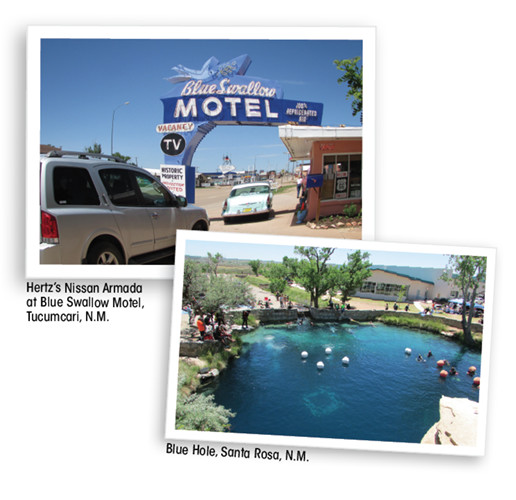 Day 3
Day 3
Amarillo to Santa Fe, New Mexico
Heading out of Amarillo, make a quick stop at the Cadillac Ranch, where an eccentric millionaire buried a dozen graffiti-strewn Caddies nose-down and fins-up. After leaving Texas, the vistas in New Mexico look mighty pretty.
In Tucumcari ("The Town That's 2 Blocks Wide and 2 Miles Long"), notorious for "Tucumcari Tonight" billboards aimed at sleepy travelers, it's all about Route 66. Fellow fans are everywhere!
Tour the Blue Swallow Motel, where each guestroom has its own garage, and eat lunch at Kix on 66, a retro diner. Pull off at the Blue Hole in Santa Rosa, an 80-foot-deep artesian well crowded by scores of divers from all over the West due to its clear, 61-degree water.
Travel the oldest version of Route 66 (the thoroughfare was adjusted several times over the years). There's not another vehicle in sight - just the occasional ranch.
In Ribera, watch a few wild peacocks roam the grounds of San Miguel Del Vado Catholic Church, an adobe-walled structure built in 1804 and recently refurbished. Still in operation, it remains much the same as when the Santa Fe Trail crossed the Pecos River.
In Ribera's general store, encouraged to try the local favorite, Frito pie (chili poured over corn chips in the open bag). Instead, wander into the 100-year-old, low-slung building that houses La Risa Cafe, a delish outpost owned by Laura Boyd-Martinez and her husband. Order blue corn cheese enchiladas (yum!), and hear for the first time the official state question, "red or green?" Chili, that is!
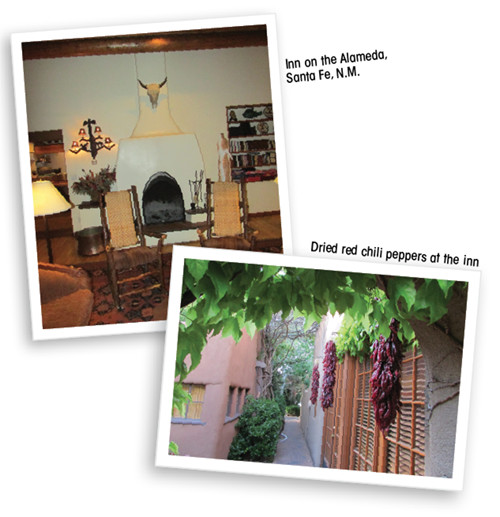 Days 4 & 5
Days 4 & 5
Santa Fe
Try to pack a week's worth of sightseeing into two days in New Mexico's state capital (dating back to 1610, it's the oldest capital in the United States), a cultural crossroads of the Southwest.
This cosmopolitan city is infused with art, history and beauty. World-class galleries on Canyon Road, which angles up and up and up from the town center; Georgia O'Keefe Museum; traditional handicrafts sold by local artisans; Santa Fe Opera House; luminous skies and clear air; Native American Art Museum; Palace of the Governors; brightly colored restaurants serving global cuisine; Museum of International Folk Art; thick-walled adobe architecture in terra cotta hues. Whew!
Toss off shoes and collapse on the cushy bed at the Inn on the Alameda, a lovely place a few blocks from the Plaza, the city's heartbeat and a focal point for tourism.
The inn goes above and beyond for its guests. Complimentary are local van service; afternoon wine and snacks in the comfy lobby; and a freshly made breakfast buffet highlighted by veggie frittata; bread-pudding-style French toast; quiche; and, of course, red and green chili sauces.
 Day 6
Day 6
Santa Fe to Gallup, New Mexico
Detour to Taos takes us on the "high road" past scruffy villages punctuated by studios and galleries. The free-spirited residents of Taos relish its bohemian take on the arts.
Swing over to Taos Pueblo, at the base of the Sangre de Cristo mountain range, where the rustic, multi-storied adobe buildings have been continuously inhabited for 1,000 years. A handful of tribe members still live here sans plumbing and electricity. Upper floors are accessed by ladders propped against the outside walls.
The pueblo is known for fry bread made in modest clay ovens and art created in first-floor shops. Christopher Lujan, a soft-spoken jeweler taught by his father, makes a thick sterling-silver ring embossed with Native American symbols for us.
A few miles from Taos, examine Earthship Biotecture, a scattered collection of whimsical houses for people who want to live sustainably and off the grid.
Put the pedal to the metal for the journey to Gallup, the unofficial business capital of the Navajo Nation, where there's a lineup of trading posts filled with local arts and crafts. The recently opened Hilton Garden Inn is a welcome respite from the dusty byway.
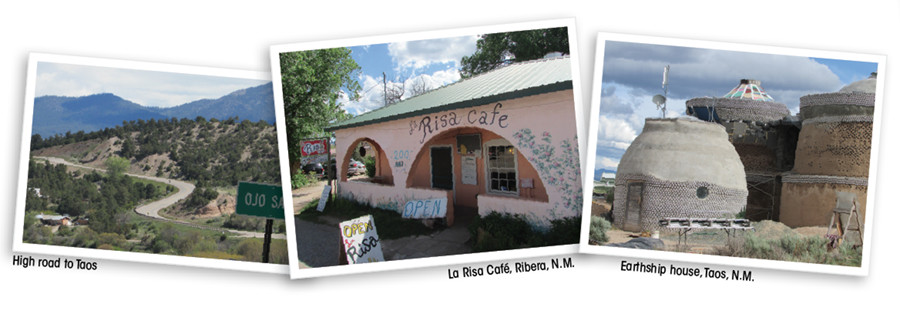
 Day 7
Day 7
Gallup to Flagstaff, Arizona
Ask at the front desk which trading post to patronize in order to buy authentic jewelry. Nothing downtown, we're told. Shop where the locals do: Richardson's Trading Co. & Cash Pawn.
Track down this unique blend of grocery store, pawn shop and outlet for tribal art. A friendly clerk gives us a lesson on how to tell real turquoise from fake, and we walk away satisfied with a one-of-a-kind handmade necklace.
Come to a screeching halt in Winslow so we can take the requisite picture standing next to the statue of a guitarist on a downtown corner. Why? Blame the Eagles. In their 1972 song "Take It Easy," the rock band sings, "I'm a standing on a corner in Winslow, Arizona, and such a fine sight to see."
Take a spin through Petrified Forest National Park and Painted Desert, which feature 93,000 acres of wood that, effectively, turned to stone over many millennia. Wind and rain in the broad badlands revealed layers of minerals, which shimmer in gold, red and purple.
Just outside Flagstaff, an outdoorsy college town that's strikingly situated at 7,000 feet, settle into a room at the Twin Arrows Casino, one of several gambling resorts run by the Navajo Nation. With a view of the San Francisco Peaks, Twin Arrows is the tribe's premiere property. No Las Vegas gaudiness here. Instead, art and décor are symbols with deep tribal meaning.
Day 8
Flagstaff to Williams, Arizona
Make tracks to Williams to catch the vintage Grand Canyon Railway. The steam locomotive provides an entertaining (cowboys, bandits, sheriffs) two-hour chug north to the jaw-dropping granddaddy of Western tourism.
Circle the world's most magnificent hole in the ground on a comfortable motor coach with an engaging driver/guide. He amuses us with the dumbest questions he has been asked, including, "How long does it take for a deer to become an elk?"
Overnight at the Grand Canyon Railway Hotel, a well-kept nod to a bygone era, in Williams. Once home to bordellos and saloons, the "Gateway to the Grand Canyon" now comes complete with morning and afternoon Wild West shows and cowboy gunfights.
Williams presents Route 66 in overdrive, too. Neon lights, soda fountains, classic cars, nostalgia – it's all here and lots of it.
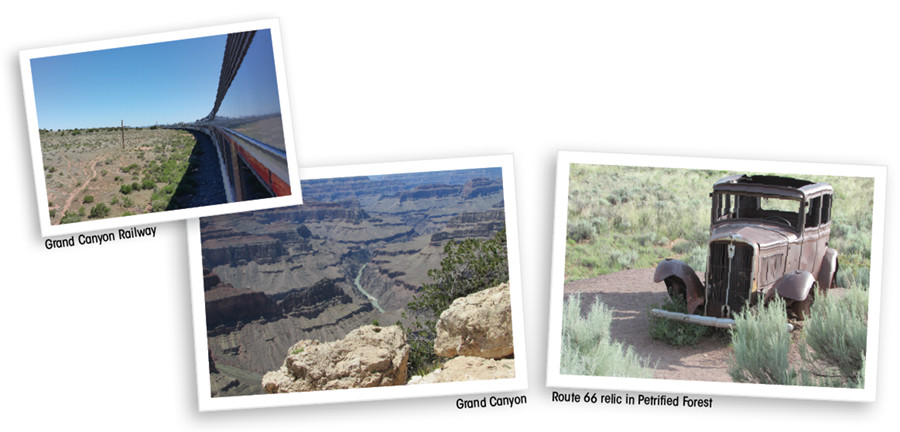
 Day 9
Day 9
Williams to Pasadena, California
Hightail it to Seligman, the consummate Route 66 strip. Angel Delgadillo, a sprightly barber who holds court in a shop with a striped red, white and blue pole, was an early advocate for transforming the tiny town into an attraction. Want to sit in the well-worn chair and get a haircut, but he's so popular we can't get an appointment!
On the same block, his brother Juan patched together the Snow Cap Drive-In with zany found materials. Fans flock to grab a cone at the roadside curiosity, now run by his children, which features wacky signs like "Sorry, We're Open."
A sense of humor seems required in this burg – note the tongue-in-check name for another eatery, Roadkill Café.
Climb over steep mountains on a narrow roadway cutting across a harsh stretch of desert, where store owners don't hesitate to display their guns in tooled leather holsters. After a twisting drive, reach Oatman, where plank sidewalks, hitching posts and dirt streets resemble the set of a John Wayne film.
In the 1930s, Oatman's gold mines attracted 10,000 residents, who guzzled libations at 20 saloons along Main Street. Today, signs of life include the adorable, but wild, burros who lumber about looking for culinary handouts from storekeepers and devotees of the old road.
Loop to Lake Havasu City, a modern vacationland and retirement hub built around a surreal centerpiece. Surprised to find the London Bridge (the real one!) in the middle of the Arizona desert.
The 1830s London Bridge was replaced with concrete in the 1960s, when the old parts were put up for sale. At the cost to a developer of $10 million, 10,000 stones were shipped to Lake Havasu City and reassembled, generating an incongruous Ye Olde England atmosphere.
Soldier through the Mojave Desert, where it's 110 degrees. You know how they say that searing temperatures don't matter when there's no humidity? They're wrong! Instead of steaming, we're baking.
Settlements, such as Newberry Springs with its Bagdad Café (made famous by the 1987 film of the same name), are few and far between. At one point, a sign says, "Next service, 56 miles." When the rest stop materializes, a dozen women clamor to use one bathroom.
Make it to Pasadena and civilization. And what a civilization! Uniformed bellmen greet us at the Langham Huntington, an oasis of grandeur nestled at the base of the San Gabriel Mountains. From the balcony of our elegantly furnished suite at this Southern California landmark, we have expansive views all the way to Los Angeles and the Pacific Ocean.

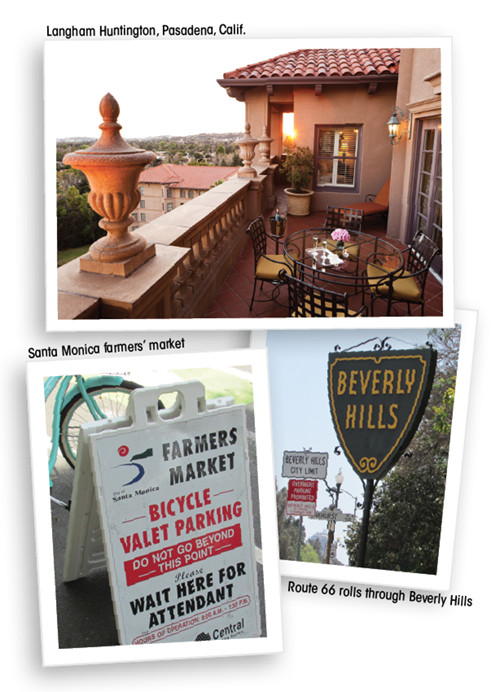 Day 10
Day 10
Pasadena to Santa Monica, California
Race around the lush Huntington Library, Museum & Gardens, attempting to absorb everything. Spend hours in the library, pouring over a splendid collection of rare books, prints, photographs and maps. Linger over manuscripts of Chaucer's "Canterbury Tales" and Henry David Thoreau's "Walden" as well as the Gutenberg Bible and John James Audubon's "Birds of America."
Rather than squeeze onto the clogged freeways, meander along historic Route 66, passing Hollywood studios and Beverly Hills mansions.
Reach the terminus of the Mother Road in Santa Monica. Serendipity strikes! Pull into a parking spot right in front of the plaque that marks the glorious spot.
Sunny Santa Monica is very stylish - even at its weekly farmers' market, where a "bicycle concierge" does business at a brisk clip. The picture-postcard pier, with old-time carnival games and rides, has been the backdrop for many blockbuster scenes in movies.
In our room at the Ocean View Hotel, a recently renovated boutique property, we throw open the doors to the balcony to take in the sea, the sand and the Santa Monica Pier as the sun dives below the horizon - a perfect end to a beautiful journey.
